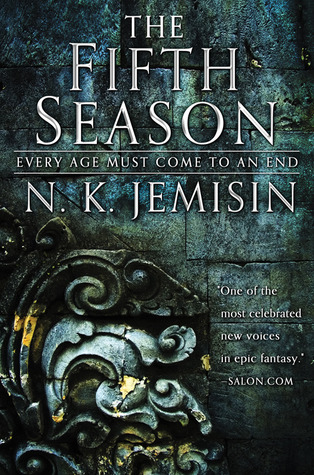In a world where the ground beneath our feet can shift in an instant, N.K. Jemisin’s “The Fifth Season” serves as a poignant exploration of societal collapse and renewal. Set against a backdrop of seismic upheaval—both literally and metaphorically—this masterful narrative invites readers to confront the fragility of civilization and the resilience of those who endure its tumult. As Jemisin weaves a tale of oppression, survival, and the intricate tapestry of human relationships, she not only captivates the inventiveness but also challenges us to reflect on our own society’s vulnerabilities.In this review, we delve into the layers of Jemisin’s work, unearthing the themes of power, identity, and the price of change that resonate long after the last page is turned.
Exploring the Foundations of a Crumbling Civilization in The Fifth Season
N.K. Jemisin masterfully crafts a world that has witnessed repeated cataclysms,exploring the intricate webs of dependency that bind its inhabitants to both their environment and each othre. the narrative brings forth a haunting sense of futility that permeates the lives of the orogenes, individuals capable of manipulating geological forces.Societal collapse is not merely a backdrop but a character in its own right, represented through visceral imagery and rich symbolism. Through the lens of oppression and survival, Jemisin illustrates how the dreams of a once-thriving civilization crumble under the weight of systemic injustices, environmental neglect, and fear of the unknown, invoking a profound reflection on our own world’s precarious foundations.
The artistic representation of crumbling structures, both literal and metaphorical, emphasizes the fragility of progress, showcasing how societal norms can be both a source of strength and a weapon wielded for control. Key themes emerge as Jemisin delves into the dynamics of power and the ways in which societal hierarchies are maintained, questioning the morality behind survival in such a harsh landscape. Notably, the following elements encapsulate the essence of this crumbling civilization:
| Aspect | Impact on Society |
|---|---|
| Environmental Catastrophe | Creates despair and desperation among the populace. |
| Systemic Oppression | Maintains social hierarchies and control over orogenes. |
| Community Dynamics | Fosters bonds yet reveals deep-seated mistrust. |
| Rebellion and Resistance | Signifies hope amidst despair, pushing for change. |
Interwoven Narratives: Perspectives Shaping Jemisin’s Unique Storytelling
N.K. Jemisin’s storytelling in ‘The Fifth Season’ is a masterclass in weaving complex narratives that challenge customary storytelling conventions. Each character’s viewpoint adds a rich layer to the world-building, inviting readers to experience the societal collapse through various lenses. The novel intricately combines themes of oppression, resilience, and environmental catastrophe, allowing Jemisin to illustrate the interconnectedness of personal and societal crises. By employing a first-person narrative style intermingled with second-person addresses, she envelops readers in the emotional turmoil and urgency that permeates the world of Orison. This unique approach immerses the audience into the psyche of the characters,ensuring that each emotional beat resonates on a deeper level.
The author’s ability to craft these interwoven experiences stems from her keen observation of cultural histories and contemporary societal issues. The characters, portrayed as both products and rebels of their environment, reflect the complexity of human emotions against the backdrop of a decaying world. Jemisin meticulously juxtaposes the harsh realities of oppression with the subtler nuances of individuality and agency, revealing how trauma can both fracture and forge communities. This alignment of personal histories with a larger socio-political narrative creates a tapestry that is not only engaging but also thought-provoking. Readers are left to ponder the implications of resilience,human connection,and the ongoing struggle against systemic injustices.
Characters as Catalysts: The Depth and Complexity of Human Emotion
N.K. Jemisin skillfully crafts her characters in *The Fifth Season*, positioning them as mirrors reflecting the intricate tapestry of human emotions. Each character embodies a spectrum of feelings that resonate with readers, prompting us to confront our own complexities. The struggles of Essun grapple with grief and anger, revealing the profound pain of loss intertwined with a desperate quest for understanding. In contrast,Syenite’s desire for agency in a system that seeks to suppress her potential unveils the complexities of desire,hope,and rebellion against oppression. Through their experiences, Jemisin invites us to explore the depths of empathy, compelling us to question the societal norms that dictate the boundaries of human emotion.
Moreover, the interconnections between characters further amplify the exploration of emotional depth. Relationships in this broken world are fraught with tension and resilience,serving as a catalyst for character evolution.As Jemisin weaves their stories together, we witness:
- Conflicted loyalties—characters torn between personal aspirations and societal expectations.
- Enduring love—bonds that transcend fear and chaos,showcasing the strength found in vulnerability.
- Shared trauma—the collective suffering that unites individuals in a shared emotional landscape.
This dynamic interplay of characters not only advances the plot but also enriches the reader’s emotional journey, creating a poignant exploration of what it means to be human in the face of societal collapse.
The Role of Climate Change: An Allegory for Our Contemporary Crisis
The world of N.K. Jemisin’s The Fifth Season serves as a haunting reflection of our own planet’s struggles with climate change, drawing a parallel between the catastrophic events within the novel and the ongoing crises facing our society. As the characters grapple with a world ravaged by seismic disruptions, readers are invited to consider the implications of living in a precarious environment where survival hinges on adapting to the unpredictable.Societal structures are depicted as fragile, echoing the very real vulnerabilities we face with the rise of extreme weather events and resource scarcity, highlighting our collective inability to address these looming threats effectively.
In the narrative, the concept of ”orogeny”—the ability to manipulate geological forces—functions as an allegory for the power and responsibility humanity possesses in relation to climate change. the duality of this power is palpable; it can be a source of salvation or destruction, paralleling the potential outcomes of our current environmental policies. As Jemisin weaves different social classes and their responses to disasters, she emphasizes the unequal burden borne by marginalized communities, mirroring real-world disparities. The narrative urges us to confront uncomfortable truths about our environment, compelling us to ask: what happens when those in power fail to heed the signs of impending crisis?
| Theme | Description |
|---|---|
| Environmental Instability | The unpredictable nature of the environment in the novel reflects the increasing frequency of climate catastrophes today. |
| Social Inequality | Communities in the novel show how the impacts of disasters disproportionately affect vulnerable populations. |
| Power Dynamics | The manipulation of natural forces parallels humanity’s struggle to harness and protect the environment responsibly. |
Diversity and Representation: How Jemisin Redefines Genre Norms
N.K. Jemisin’s work in ’The Fifth Season’ boldly confronts the traditional confines of speculative fiction by centering narratives that highlight the experiences of marginalized identities. Her characters, primarily women of color, reflect a spectrum of identities and backgrounds, offering readers a fresh lens through which to view a world steeped in chaos and change. By infusing themes of oppression, resilience, and community, Jemisin dismantles the often Eurocentric narratives that dominate the genre, creating a rich tapestry that resonates deeply with contemporary societal struggles.This novel embraces the complexities of its characters—each one flawed yet fiercely powerful—illustrating a world where survival requires forging connections across divides frequently enough wrought by fear and prejudice.
Moreover, Jemisin’s intersectional approach to storytelling invites readers to engage with issues of environmental destruction, systemic inequality, and cultural dislocation in a thought-provoking manner. The society in ‘The Fifth Season’ is defined by its crises, mirroring real-world challenges while engaging readers through a speculative lens. The carefully constructed world reflects rigorous research and imagination, offering an atmosphere where socio-political dynamics play as crucial a role as individual journeys. Through her innovative narrative technique, Jemisin not only redefines genre norms but also reclaims the very act of storytelling, ensuring that diverse voices and experiences are not just heard but celebrated. The result is a work that transcends mere entertainment, becoming a vital commentary on the world we inhabit.
Language as Power: The artistry Behind Jemisin’s Prose and Dialogue
N.K. Jemisin wields language with a deft touch, transforming the intricate tapestry of her world into a vivid, tangible experience. Each word in her narrative serves not merely as a vehicle of storytelling but as a formidable tool of power, capable of shaping the perceptions and realities of both characters and readers alike. Through a careful selection of lyrical prose,Jemisin crafts a voice that resonates deeply,immersing readers in a universe fraught with turmoil yet rich in beauty. Her dialogue frequently enough transcends mere conversation, becoming a pivotal element in revealing character motivations and societal tensions, allowing us to witness the nuances of oppression and resistance in an acutely complex world.
At the heart of her storytelling lies the duality of language as both a weapon and a refuge.The characters in ‘The Fifth Season’ navigate a landscape laden with miscommunication and misunderstanding, underscoring the chasms that exist between different factions of society. This subtext is further illuminated through powerful exchanges that echo the struggles of marginalized voices in our own world. To illustrate this dynamic, the following table highlights key dialogues and their implications:
| Dialogue | Character | Societal Implication |
|---|---|---|
| “You will never be whole.” | Essun | Isolation in a fragmented society |
| “What is strength if not fear?” | Syenite | Resilience born from oppression |
| “we are all in this together.” | Alabaster | Unity amidst chaos |
Themes of Resilience and Survival: Echoes of Humanity in Despair
At the heart of N.K. Jemisin’s narrative lies a compelling exploration of resilience amidst turmoil. Characters are thrust into unimaginable circumstances, forcing them to navigate a world fractured by natural cataclysms and societal breakdowns.The embodiment of survival is not merely a physical act but a profound demonstration of emotional tenacity and communal bonds. Jemisin intricately weaves the struggles of her characters with themes of identity and belonging, allowing readers to witness how they adapt and rise from the ashes of despair.the portrayal of these diverse experiences reflects the multifaceted nature of humanity, showcasing the unyielding spirit that emerges even when faced with insurmountable odds.
The novel also delves into collective survival through the lens of marginalized communities. By highlighting their interconnectedness, Jemisin emphasizes the importance of solidarity in overcoming adversity. She crafts a world where hope is not just a fleeting emotion but a powerful catalyst for change. Consider the following aspects of resilience illustrated in the text:
- Community Strength: Characters find solace and strength in their relationships, fostering a support system that empowers them to endure.
- Adaptability: Each character demonstrates a remarkable ability to adjust their survival strategies in response to shifting external crises.
- Empathy: The narrative highlights the importance of understanding others’ struggles,showcasing how shared experiences can unite individuals.
| Character | Resilience Trait | Role in Survival |
|---|---|---|
| Essun | Tenacity | Leader of her family |
| Syenite | Resourceful | Strategizes to survive |
| Alabaster | benevolence | Inspires hope |
N.K. Jemisin’s ability to evoke multiplicity in experiences of resilience speaks to the broader human condition, challenging readers to reflect on their own capacities for survival and growth in the face of despair. The echoes of humanity resonate throughout the narrative,encouraging a collective reflection on the threads that bind us together as we navigate through our own societal or personal upheavals.
World-Building Mastery: Crafting a Realistic and Intricate Landscape
in N.K. Jemisin’s “The Fifth Season,” the world is a complex tapestry of environmental extremes and societal hierarchies. The precariousness of living on a planet besieged by catastrophic seismic events serves as a reflection of the characters’ tumultuous lives. The landscape is not merely a backdrop; it is indeed a character in its own right, considerably influencing the behaviors and fates of its inhabitants. Jemisin’s use of detailed descriptions allows readers to visualize the world vividly, understanding its geography as inherently tied to the oppression and survival of its people. Key aspects of this landscape include:
- Obelisks of ash: monoliths scattered throughout the world, signifying a past filled with devastation.
- Floating islands: Unique and eerie landforms driven by the seismic activity that challenge the norms of survival.
- Ravines and chasms: Physical manifestations of societal divides, illustrating the fragmentation within communities.
The intricacy of Jemisin’s world-building is further enriched by the diverse cultures that exist within it. Each societal group has adapted uniquely to their harsh environment, cultivating distinct practices, beliefs, and hierarchies. This cultural tapestry works in concert with the geography, weaving together a rich narrative about how environment influences societal structures. Some vital cultural elements include:
| Culture | Key Practices |
|---|---|
| Sojourners | Nomadic, adapting to constant change |
| Fellows | Communal living, collective survival tactics |
| Orogenes | Harness seismic powers, frequently enough marginalized |
The Intersection of Magic and Reality in a Shattered World
In N.K. Jemisin’s ‘the Fifth Season’, the fabric of reality is intricately woven with strands of magic, creating a haunting tapestry that reflects the chaotic state of a world on the brink of collapse. The use of orogeny—the ability to manipulate geological forces—serves not only as a potent tool but as a unique lens through which to explore the fragility of societal structures. The orogenes, often marginalized and feared, highlight a society built on oppression, control, and fear, forcing the reader to confront uncomfortable truths about power dynamics and the systemic inequalities that pervade human existence. As the world shatters, both literally and metaphorically, Jemisin masterfully blurs the lines between magic and reality, inviting readers to ponder the implications of both on our lives.
Through this lens, Jemisin examines the inherent dichotomies of human nature: creation and destruction, power and vulnerability. The fractured world of ‘The Fifth Season’ presents a chilling mirror to our own, reminding us that the elements we often think of as magical can also be a reflection of our deepest fears and societal failures. Consider the following contrasts depicted in the narrative:
| Magic | Reality |
|---|---|
| Orogeny as a force of creation | Destruction of communities due to fear |
| Connection to the earth and its power | Exploitation by those in authority |
| Potential for harmony with nature | Conflict stemming from misunderstanding |
Each story arc challenges our understanding of what it means to be powerful and how such power is wielded. Jemisin’s nuanced portrayal encourages a deeper engagement with the real-world ramifications of societal collapse, emphasizing that the magic we crave frequently enough lies in our ability to confront our uncomfortable truths and forge new paths amid the ruins.
Innovative Structure: The Unconventional Approach to Storytelling
N.K.Jemisin masterfully disrupts traditional narrative structures in “The Fifth Season,” weaving multiple perspectives that challenge readers to reconsider the very fabric of storytelling. By employing an innovative approach that blends second-person narration with stream-of-consciousness, Jemisin creates an immersive experience that compels the audience to actively engage with the narrative. As readers navigate through the turbulent world of orsay, they are not merely passive observers but are instead thrust into the characters’ emotional and psychological depths. This distinctive style reflects the chaotic environment of a society on the brink of collapse, effectively mirroring the themes of disarray and survival.
Jemisin’s unconventional choices also extend to the structure of the plot, marked by nonlinear timelines and fragmented narratives that echo the shattered lives of her characters. Key elements include:
- Multiple POVs: Insight into diverse experiences and socio-political dynamics.
- Layered storytelling: Blending myths with personal histories to enrich the context.
- emotional resonance: certain events are revealed through characters’ reflections, adding depth to their motivations.
This tapestry of voices and timelines not only enhances the thematic richness of Jemisin’s work but also invites readers to grapple with the complexities of identity,power,and resilience in the face of societal disintegration.
Lessons from Collapse: Reflections on Society and Human Behavior
In exploring the intricate layers of human behavior in times of crisis, N.K. Jemisin’s ‘The Fifth Season’ serves as a profound reflection on our societal structures.The novel illustrates how fear, power dynamics, and inequality can spiral into chaos, demonstrating that societal collapse is not just a matter of external forces but often rooted in the very fabric of human relationships. Characters in the narrative embark on harrowing journeys that reveal the fragility of trust and bonds, raising critical questions about what it means to belong in a fractured world. From this, we discern significant lessons about the ways in which community and individuality clash, frequently enough leading to moments that define and redefine our existence.
Furthermore, Jemisin challenges readers to confront uncomfortable truths about complacency and complicity within society. The stark inequalities portrayed are reflective of issues that resonate in our own world,prompting thoughts on:
- responsibility: Who bears the weight of societal failure?
- Resilience: In what ways can communities rebuild after trauma?
- Empathy: How can understanding across different experiences promote healing?
The novel deftly suggests that the path to reconciliation is littered with the remnants of what was lost,urging readers to examine their roles in fostering,or hindering,collective growth. through its haunting narrative and richly developed characters, ‘The Fifth Season’ functions not merely as a tale of survival but as a mirror reflecting our own societal shortcomings and potential for renewal.
Reader Engagement: How The Fifth Season Provokes Thought and Discussion
N.K. Jemisin’s “The Fifth Season” masterfully plunges readers into a world that is both alien and achingly familiar. Through its intricate narrative and rich character advancement, the novel forces readers to confront uncomfortable truths about society, power dynamics, and resilience. At the core of its story lies a myriad of themes ripe for discussion, such as the consequences of oppression, the fragility of civilization, and the importance of community. By depicting a collapsing world shaped by geological cataclysms and social injustices, Jemisin invites readers to reflect on contemporary issues of climate change, systemic inequality, and the erosion of societal trust.
As readers traverse the harsh landscapes of orogeny and societal collapse, they are compelled to engage in discussions that extend beyond the text. The novel serves as a springboard for dialogue on pivotal questions, such as:
- What defines humanity in the face of catastrophe?
- How do we recognize and resist systems of oppression?
- In what ways can community solidarity emerge from adversity?
These discussions can be further enriched by exploring character motivations and the impact of their choices within this tumultuous world. Readers often find themselves reflecting on parallels with their realities, making “The Fifth Season” not just a story, but a catalyst for vital conversations that resonate well outside the pages of the book.
N.K. Jemisin: A Visionary Writer shaping the Future of Speculative Fiction
N.K. Jemisin’s ‘The Fifth Season’ intricately weaves a narrative that confronts themes of societal collapse through a lens that is both imaginative and deeply resonant. The novel is set in a world plagued by apocalyptic climate phenomena, where the very fabric of society is at constant risk. Jemisin’s ability to craft characters who embody the struggles against systemic oppression adds a layer of complexity to an already multifaceted world. Readers are introduced to three women, each with their own burdens and strengths, and through their journeys, the novel challenges traditional narratives around power, resilience, and survival. This approach not only immerses readers into the chaotic landscapes of orogeny but also prompts reflection on contemporary societal issues, making it a remarkable commentary on our own world.
Furthermore, Jemisin’s world-building is an innovative exploration of cultural histories and practices that shape the inhabitants’ daily lives. The novel presents a stark dichotomy of social classes, highlighting the inequities faced by those who possess the power of orogeny, frequently enough referred to as “Origins.” through vivid descriptions and thought-provoking dialogue, readers are urged to confront the biases and injustices that are prevalent in their own societies. The storytelling is paired with a unique narrative structure that shifts between perspectives and timelines, creating a rich tapestry that is both compelling and thought-provoking.In this very way, Jemisin not only creates an engaging story but also prompts critical discourse about the socio-political environments we navigate today.
- Creative World-Building: Unique settings with rich cultural backgrounds.
- Character-Driven Narrative: Strong female protagonists facing societal challenges.
- Themes of Survival: Exploration of resilience in the face of collapse.
- Critical Social Commentary: Reflections on justice and inequity.
In Summary
“The Fifth Season” stands as a remarkable exploration of societal collapse through the lens of N.K. Jemisin’s vivid imagination and masterful storytelling. As we turn the final pages, we are left not only with a rich tapestry of characters and a world meticulously crafted but also with profound questions about humanity’s resilience and adaptability in the face of cataclysm. Jemisin does not merely offer a narrative of despair; she invites us to confront the complexities of power, identity, and survival, urging readers to reflect on the fragility of our own systems and the potential for rebirth amidst ruin.
This book prompts us to examine our current reality and consider the lessons woven into its pages, revealing that every collapse carries with it the seeds of transformation. Whether you come to it as a fan of speculative fiction or as a seeker of deeper truths,”The Fifth Season” beckons you to unearth the layers of its concern and wonder.N.K. Jemisin has carved a space where the intricacies of life and the consequences of our choices collide, urging us to not just witness but to engage with the narrative of our own existence. As we step away from this powerful tale, we are reminded that every ending, no matter how tumultuous, might just herald a new beginning.













